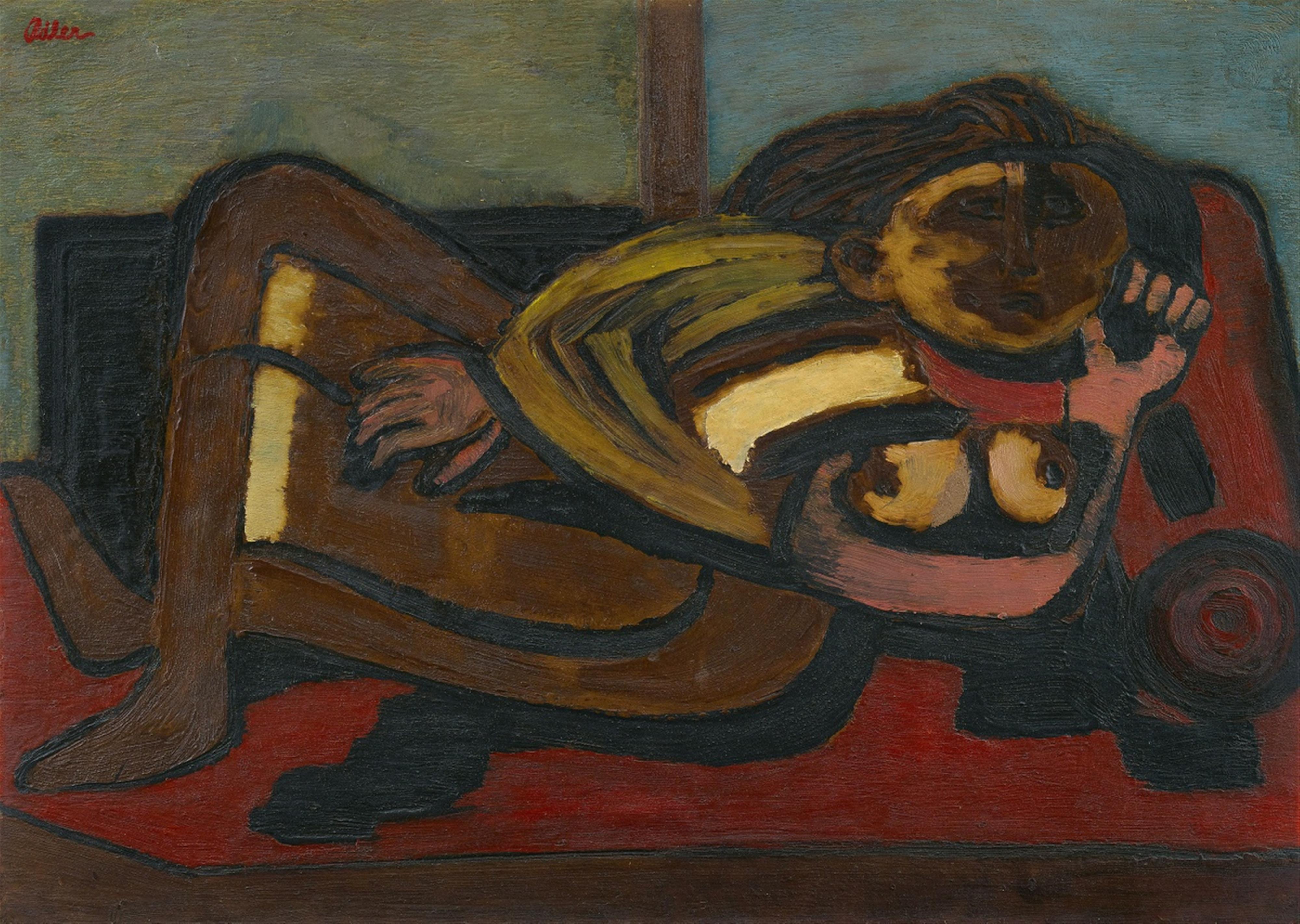Jankel Adler
Liegendes Mädchen (Reclining Girl)
1941
Oil and sand (on thin card) on plywood 55,5 x 77,5 cm Framed. Signed 'Adler' in red upper left. - The pastose colour appliance partially with craquelure. Singular losses of colour, with former professional conservatory restoration.
Jankel Adler's “Liegendes Mädchen”, an opaque composition in darkly glowing colours, was created during his exile in Scotland; the artist had joined Polish troops as a volunteer in France in 1940 and then become stranded in Glasgow with them after fleeing from the German army via St Nazaire. In spite of a heart ailment, to which Jankel Adler would succumb in Aldbourne in 1949, at the age of just 53, this was followed by a few years filled with intense work and new friends. He found many other exiles in Glasgow and London, and new circles and communities formed on account of the war. As a painter he was an influential presence there, even among British artists and writers, Jankel Adler is said to have been relatively close friends with Samuel Beckett, in particular.
Jankel Adler's own work underwent a new change in 1941: “He wanted to survive as an artist, as an individual who could use artistic form to bear witness: 'The outward form of each and every thing and each and every person bears the stamp of fate, but this language can only be deciphered by an intellectual mechanism like that of a chosen individual, the artist'” (Jankel Adler, 1929, cited in Ulrich Krempel, Vom Expressiven zum Konstruktiven, von der Sachlichkeit zum Abstrakt-Symbolischen, in: exhib. cat., Düsseldorf/ Tel Aviv/ Lodz, op. cit., 1985, p. 195 and annot. 15, p. 200).
In this sense, in the figural motif of “Liegendes Mädchen” from 1941, many elementary constants that had already distinguished Jankel Adler's work since the 1920s are interwoven with the formulations of an abstraction that had since become modified and even more radical. Typical elements, such as the picture's distinctive materiality and two-dimensional organisation, the monumental understanding of the human figure and the gestural aspect are older, unmistakable fixed constants of this kind. The strongly formalised and emphasised linear contours, decisive shifts of viewpoint within the figure, compartmentalisation of details and the abstract dynamism of the interior structures are new expressive elements. For Jankel Adler these stylistic breaks were the result of outward as well as inner necessities, shaped not least by his personal encounter with Paul Klee and - after 1933, during his exile in France - his experience of the world of Pablo Picasso's forms and images.
Catalogue Raisonné
Heibel II, 197; Charles Aukin 52 (London Estate listing)
Provenance
Possession of the artist until 1948; Charles Aukin (assignment according to Heibel); Gimpel Fils, London (acquired there mid 1970s); since then Collection Tamara and Schmuel Givon, Tel Aviv, Family possession
Literature
Paul Fierens, Jankel Adler, London/ Paris 1948, with illus. 14; Stanley William Hayter, Jankel Adler, London/ Paris/ Brüssel 1948, with illus. 14; Joanna Pollakówna, Die gerettete Welt. Über Jankel Adlers Malerei, in: Jürgen Harten (ed. i.a.), Jankel Adler 1895-1949, exhib. cat. Düsseldorf/ Tel Aviv/ Lodz, Cologne 1985, p. 250; cf. Anne Mitzen, Umbrüche, Experiment und Transformation in den 1930er Jahren: Jankel Adler im Dialog mit Paul Klee, Stanley W. Hayter und Pablo Picasso, in: Antje Birthälmer/ Gerhard Finckh (ed.), Jankel Adler und die Avantgarde, Chagall/ Dix/ Klee/ Picasso, exhib. cat. Von der Heydt Museum, Wuppertal 2018, p. 131 ff., as well as on the British Exile, Sarah MacDougall and Rachel Dickson, ibid., p. 145 ff.
Exhibitions
London 1946 (Anglo-French-Art-Center), Jankel Adler, Francis Bacon, Robert Colquhoun, Hubert, Robert MacBryde, Julian Trevelyan (according to Heibel documented by photograph); London 1959-1961 (Waddington Galleries, according to Heibel through Charles Aukin); Edinburgh/ Glasgow/ Aberdeen 1968 (Scottish National Gallery of Modern Art/ Scottish Arts Council Gallery/ Art Gallery and Regional Museum), New paintings in Glasgow 1940-1946, no. 4; Tel Aviv 1977 (Rosenfeld Gallery), Jankel Adler, no. 5; Düsseldorf/Tel Aviv/Lodz 1985/1986 (Städtische Kunsthalle/The Tel Aviv Museum/Museum Sztuki), Jankel Adler, cat no. 84 (verso with exhibition label of Tel Aviv Museum, here cat. no. 65)

